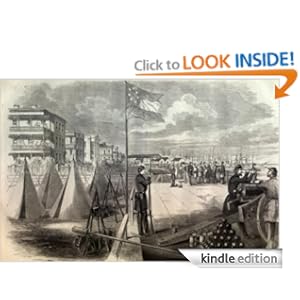There was a time when i was absolutely fascinated by the American Civil War. I read every book (reviews to come) I could get my hands on, scoured websites, went on battleground field trips and talked to other aficionados. To this day I still have a big interest in that time period, even though not as enthusiastic.
At the time of this post, the books below were free or $0.99 — please check before downloading.
Authors: If you’d like your book to be featured on Tightwad Tuesdays pleaseemail me.
Battles and Leaders of the Civil War: The Struggle for Round Top (Illustrated)
by Evander M. Law
*Illustrated with maps and pictures of the battle and its important generals
*Includes Table of Contents
Without question, the most famous battle of the Civil War took place outside of the small town of Gettysburg from July 1-3, 1863. Over those three days, nearly 8,000 would die, over 30,000 would be casualties, and the most famous attack of the war, Pickett’s Charge, would fail Robert E. Lee’s Army of Northern Virginia.
The South would go on to lose the war, and when it did, the importance of Gettysburg as one of the “high tide” marks of the Confederacy became apparent, making the battle all the more important. Former Confederate comrades like James Longstreet and Jubal Early would go on to argue who was responsible for the loss at Gettysburg in the following decades.
The reputation of Gettysburg remained solid after the war, but interest in Little Round Top and its impact on the battle in Day 2 was heavily revived as a result of Michael Sharaa’s book Killer Angels, a very popular fictional account of the Battle of Gettysburg that hewed closely to what happened. When Sharaa’s book was turned into the movie Gettysburg, the popularity of the movie led to renewed interest in the 20th Maine’s actions on Day 2 at Gettysburg as the far left unit on the Union army’s flank. There is still debate over whether Colonel Chamberlain ordered a charge down Little Round Top when the regiment ran out of gunpowder or whether it was uncoordinated. Either way, nobody argues that the unit served with distinction, and nobody questions the importance of the Union holding onto that high ground.
Historians were less kind to Evander M. Law, brigadier-general who took command of the division on Day 2 when John Bell Hood was wounded. Law has been criticized for failing to coordinate the division, and failing to appoint a new brigade commander when he took over the division. Since Law did not writer an official report, his only remarks about his critical role came in the account he wrote after the war, which was eventually published in the famous Battles & Leaders series. This edition of Battles & Leaders of the Civil War: The Struggle for Round Top is specially formatted with a Table of Contents and pictures of Gettysburg’s important commanders.
Battles and Leaders of the Civil War: The Invasion of Maryland (Illustrated)
by James Longstreet
*Illustrated with pictures of the battlefield and Antietam’s important generals
*Includes Table of Contents
The bloodiest day in the history of the United States took place on the 75th anniversary of the signing of the Constitution. On September 17, 1862, Robert E. Lee’s Army of Northern Virginia fought George McClellan’s Army of the Potomac outside Sharpsburg along Antietam Creek. That day, nearly 25,000 would become casualties, and Lee’s army barely survived fighting the much bigger Northern army.
Although the battle was tactically a draw, it resulted in forcing Lee’s army out of Maryland and back into Virginia, making it a strategic victory for the North and an opportune time for President Abraham Lincoln to issue the Emancipation Proclamation, freeing all slaves in the rebellious states. For those reasons, Antietam is one of the major turning points of the Civil War.
One of the most prominent generals during and after the war was James Longstreet, Lee’s senior corps leader for many years in the Army of Northern Virginia. Longstreet played critical roles in battles like Gettysburg, Fredericksburg, and Antietam, and he wrote voluminously after the war defending his war record against critics. After the war, he wrote an account of the Maryland Campaign and Battle of Antietam that was eventually published in the well known Battles & Leaders series. This edition of Battles & Leaders of the Civil War: The Invasion of Maryland is specially formatted with a Table of Contents and pictures of Antietam’s important commanders.
Battles and Leaders of the Civil War: The Confederate Cavalry in the Gettysburg Campaign (Illustrated)
by John S. Mosby
*Illustrated with maps and pictures of the battle’s most famous generals.
Without question, the most famous battle of the Civil War took place outside of the small town of Gettysburg from July 1-3, 1863. Over those three days, nearly 8,000 would die, over 30,000 would be casualties, and the most famous attack of the war, Pickett’s Charge, would fail Robert E. Lee’s Army of Northern Virginia.
The South would go on to lose the war, and when it did, the importance of Gettysburg as one of the “high tide” marks of the Confederacy became apparent, making the battle all the more important. Former Confederate comrades like James Longstreet and Jubal Early would go on to argue who was responsible for the loss at Gettysburg in the following decades.
The Confederate cavalry played an especially controversial role during the campaign. Given great discretion in his cavalry operations before the battle, JEB Stuart’s cavalry was too far removed from the Army of Northern Virginia to warn Lee of the Army of the Potomac’s movements. Lee’s army inadvertently stumbled into the Union army at Gettysburg, walking blindly into what became the largest battle of the war. Stuart has been heavily criticized ever since, and it is said Lee took him to task when he arrived on the second day, leading Stuart to offer his resignation. Lee didn’t accept it, but he would later note in his after battle report that the cavalry had not updated him as to the Army of the Potomac’s movements.Renowned Cavalry officer and partisan John S. Mosby went on to write an article about the Confederate cavalry’s role in the campaign that was eventually published in the famous Battles & Leaders series. In an effort to shield Stuart, Mosby accused subordinates of disobeying commands, including Brigadier General Beverly Robertson. Robertson responded to Mosby’s charges in the same volume, and both of these articles were put together in Volume III. This edition of Battles & Leaders of the Civil War: The Confederate Cavalry in the Gettysburg Campaign includes them both. It is also specially formatted with a Table of Contents and pictures of Gettysburg’s important commanders.
Battles and Leaders of the Civil War: The Chancellorsville Campaign (Illustrated)
by Darius N. Couch
*Illustrated with maps and pictures of the battle’s important commanders
In early May 1863, the Army of the Potomac was at the height of its power as it bore down on Robert E. Lee’s Army of Northern Virginia near Fredericksburg, where the Confederates had defeated the Union the previous December. Although heavily outnumbered, Lee’s army persevered and went on to win the Battle of Chancellorsville, perhaps its most impressive tactical victory. The battle is famous for Lee’s decision to split his army in the face of the Army of the Potomac, despite being outnumbered, having Stonewall Jackson march around the Union’s right flank and surprising the XI Corps with an attack. The bold tactics eventually resulted in General Hooker ordering his army’s retreat, paving the way for Lee to invade Pennsylvania.
However, Lee would lose his “right arm” at the Battle. Stonewall Jackson had become famous for his role at the First Battle of Bull Run, the 1862 Valley Campaign, and Second Manassas, but the flank attack at Chancellorsville may have been his greatest feat in the Civil War. But Jackson was struck down the very night of the attack, mortally wounded by his own men during the night of May 2, 1863 after conducting scouting ahead of his own lines. Jackson would die 8 days later, forever crippling the Army of Northern Virginia
One of the most prominent generals during the battle was Darius N. Couch. After the war, he wrote an account of the Chancellorsville campaign that was eventually published in the well known Battles & Leaders series. As was his custom, Couch pulled no punches, analyzing the campaign and offering his suggestions on what should have been done better. This edition of Battles & Leaders of the Civil War: The Chancellorsville Campaign is specially formatted with a Table of Contents and pictures of the battle’s important commanders.
Battles and Leaders of the Civil War: The Battle of Shiloh (Illustrated)
by Ulysses S. Grant
*Illustrated
*Includes Table of Contents
After the American Civil War began in April 1861, Ulysses S. Grant made a meteoric rise to the top of the Union war effort. Illinois. On April 6, 1862 a determined full-force attack from the Confederate Army took place at the Battle of Shiloh; the objective was to destroy the entire Western Union offensive once for all. Over 44,699 Confederate troops led by Albert Sidney Johnston and P.G.T. Beauregard, vigorously attacked five divisions of Grant’s army bivouacked nine miles south at Pittsburgh Landing. Aware of the impending Confederate attack, Union troops sounded the alarm and readied for battle, however, no defensive entrenchment works had been made. The Confederates struck hard and repulsed the Union Army towards the Tennessee River. Grant and Maj. General William T. Sherman were able to rally the troops and make a stand. After receiving reinforcement troops from Maj. Gen. Don Carlos Buell and Maj. Gen. Lew Wallace’s missing division, Grant succeeded in stabilizing the Army of the Tennessee. Confederate General Johnson was killed in the battle on the first day of fighting, and on the second day, Grant launched a costly counter-offensive and pursuit that forced the Confederate Army, now under P.G.T. Beauregard, to retreat to Corinth.
The battle was the costliest in the Civil War up until this time, having 23,746 combined Union and Confederate casualties. The carnage at Shiloh demonstrated to both Confederates and Unionists that the Civil War was both very serious and extremely costly. Shiloh was the first battle in the American Civil War with tremendous casualties and Grant received much criticism for keeping the Union Army bivouacked rather than entrenched. As a result, Grant’s superior Maj. Gen Henry Halleck demoted him to second-in-command of a newly formed 120,000-strong Union Army. Grant was ready to resign from command when Maj. Gen. Sherman talked him into remaining in Halleck’s army.
Grant would go on to restore his reputation and become the North’s greatest war hero, eventually coming to command all armies and force Lee’s surrender at Appomattox, ending the war for all intents and purposes. After the war, he would write what is considered the best personal memoirs of the war as well. He also wrote an account of the Battle of Shiloh that was eventually published in the well known Battles & Leaders series. This edition of Battles & Leaders of the Civil War: The Battle of Shiloh is specially formatted with a Table of Contents and pictures of Shiloh’s important commanders.
BATTLES AND LEADERS OF THE CIVIL WAR (1884) vol. 2
Robert Underwood Johnson (Editor), Clarence Buel (Editor)
Battles and leaders of the civil war (1884) (792 pgs)
Zohar – Man of la Book







No Comments